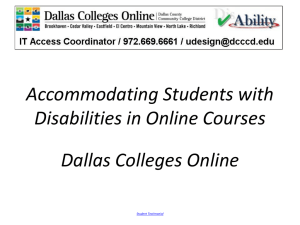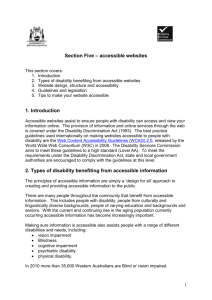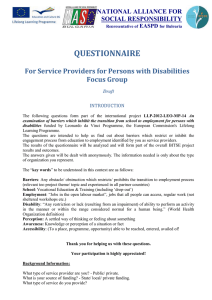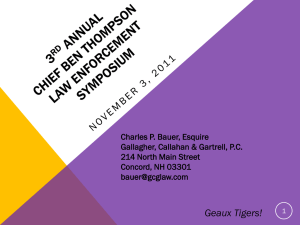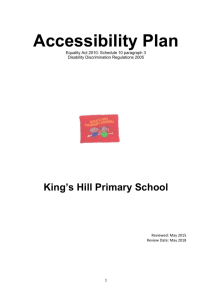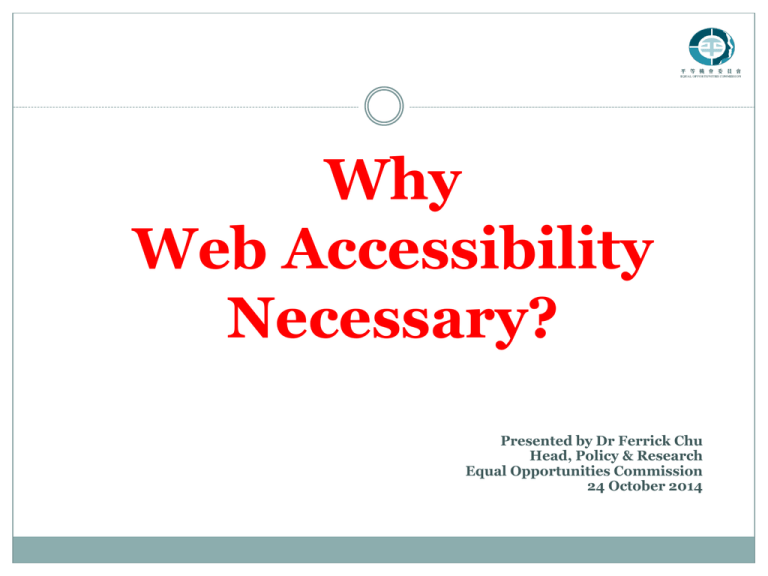
Why
Web Accessibility
Necessary?
Presented by Dr Ferrick Chu
Head, Policy & Research
Equal Opportunities Commission
24 October 2014
Some Basic Concepts
Impairment (缺損)
Any loss or abnormality of psychological, physiological, or
anatomical structure or function.
Disability (殘疾)
Any restriction or lack of ability to perform an activity in the
manner or within the range considered normal for a human being.
Handicap (障礙)
A disadvantage for a given individual, resulting from an
impairment or disability, that limits or prevents the fulfillment of a
role that is normal, depending on age, sex, social and cultural
factors, for that individual.
平等機會委員會
EQUAL OPPORTUNITIES COMMISSION
Some Basic Concepts
Equalization of opportunities
The process through which the general system of
society, such as the physical and cultural environment
(e.g. housing, transportation, healthcare, ICT,
education, work opportunities, recreational facilities
and social life, etc.) are made accessible to all.
平等機會委員會
EQUAL OPPORTUNITIES COMMISSION
Examples of Barrier
Blind – text readers & Braille output devices
cannot read information presented in graphic or
photographic format
Low vision – cannot read small fonts and
low-contrast materials
Hearing impaired – cannot access materials
available in audio format only
平等機會委員會
EQUAL OPPORTUNITIES COMMISSION
Other Considerations
People with disabilities (PWD) have, on average,
higher unemployment rate and lower incomes.
PWD may not have access to the most updated
equipment and software.
So, even if access is technically possible, a page may
not provide reasonable access in practice for PWD
and other low income groups. (e.g. aged, poor, ethnic
minorities, etc)
平等機會委員會
EQUAL OPPORTUNITIES COMMISSION
Sound Business Sense
Large number of PWD
Aging population
More people can buy products from you
Develop brand loyalty
Customers win, retailers win and shareholders win
Avoid unnecessary law suits
平等機會委員會
EQUAL OPPORTUNITIES COMMISSION
Disability Discrimination
Direct Discrimination
Less favourable treatment
On the ground of disability
Indirect Discrimination
Set same requirement / condition
Not justifiable
Disparate impact on PWD
平等機會委員會
EQUAL OPPORTUNITIES COMMISSION
Disability Discrimination
Fields covered:
Provision of goods, services & facilities
Employment
Education
Government
Access to premises
Clubs & Sporting Activities
Disposal & management of premises
平等機會委員會
EQUAL OPPORTUNITIES COMMISSION
Unjustifiable Hardship
Interpretation
Reasonableness of the accommodation
Nature of the benefit or detriment
Effect of the disability
Financial circumstances
平等機會委員會
EQUAL OPPORTUNITIES COMMISSION
Unjustifiable Hardship
Demonstrated / not simply assumed
Stylistic preferences vs functional requirements
Innovative design not prohibited
Design must address access requirements
directly or provide alternative means
平等機會委員會
EQUAL OPPORTUNITIES COMMISSION
Target.com (USA)
The National Federation of the Blind (NFB) raised
issues over inaccessibility of Target.com:
no alt-text
contained inaccessible image maps and other
graphical features, preventing blind users from
navigating and making use of all of the functions
of the website
the website required the use of a mouse to
complete a transaction, blind customers are
unable to make purchases independently
平等機會委員會
EQUAL OPPORTUNITIES COMMISSION
Target.com (USA)
NFB filed a class-action suit, with 50,000 names
In September 2006, the Federal District Court
sustained the claims against Target.com
Set the precedent that retailers must make their
websites accessible to the blind under the
Americans with Disability Act (ADA)
The legal bill outstripped the cost of the remedial
work required
平等機會委員會
EQUAL OPPORTUNITIES COMMISSION
Formal Investigation (UK)
Conducted by Disability Rights Commission
in 2004
Tested the home pages of 1,000 sites
81% websites failed to satisfy the most basic
Web Accessibility Initiative category
平等機會委員會
EQUAL OPPORTUNITIES COMMISSION
Formal Investigation (UK)
Key recommendations:
educate and train developers
mainstreaming special needs of PWD
government should raise awareness and facilitate
development of best practice guidance
should not rely exclusively on automated
accessibility testing
involve and consult disabled users
平等機會委員會
EQUAL OPPORTUNITIES COMMISSION
Developments
Country
Legislation/Guideline
Australia
• Disability Discrimination Act (DDA) of 1992
• WWW Access: DDA Advisory Notes
• The Guide to Minimum Website Standards
Canada
• Canadian Human Rights Act of 1977
• The Government of Canada Internet Guide
United
Kingdom
United States
European
Union
• The Equality Act 2010
• Formal Investigation report on Web Accessibility
•
•
•
•
American with Disability Act (ADA)
Section 508 of the Rehabilitation Act
Assistive Technology Act of 1998
Section 255 of the Telecommunications Act of 1996
• Accessibility of Public Websites – Accessibility for PWDs:
Council Resolutions, 2002
平等機會委員會
EQUAL OPPORTUNITIES COMMISSION
Advice
Consider accessibility issues at designing stage
Audit existing websites
Improve accessibility
Set performance standards
Consult users
平等機會委員會
EQUAL OPPORTUNITIES COMMISSION
Why Equal Access?
1) Fairness
2) Corporate social responsibility
3) Make sound business sense
4) Legal requirement
平等機會委員會
EQUAL OPPORTUNITIES COMMISSION
Thank you
平等機會委員會
EQUAL OPPORTUNITIES COMMISSION




